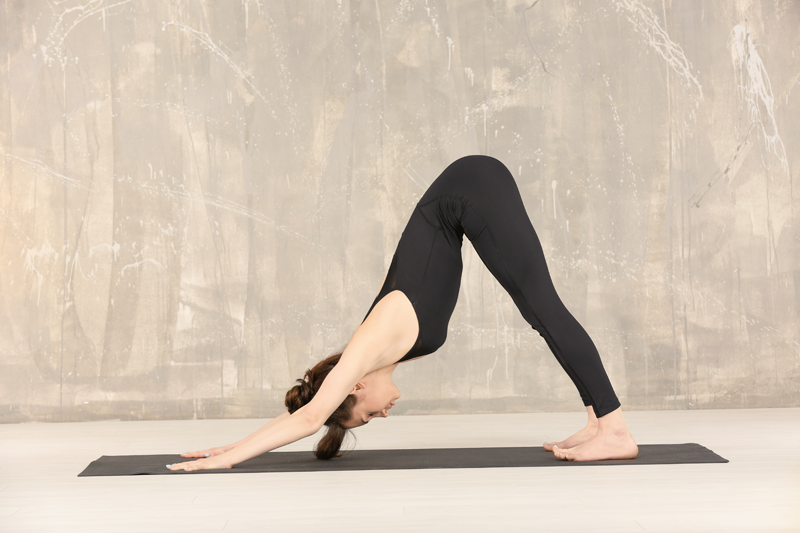When it comes to exercise, the pelvic floor is often a muscle that goes unnoticed. As we grow older or go through childbirth, though, the importance of a strong pelvic floor becomes clear. Acting as a hammock to support your organs, the pelvic floor is made up of muscles, nerves, and ligaments. When experiencing incontinence, many people assume they need to tighten up these muscles, using Kegels, for example. However, this isn’t always the solution. To create a strong, healthy pelvic floor, practising a range of stretching and strengthening exercises if often most effective.
In this article, we explore a few simple yoga poses to strengthen the pelvic floor. Before trying out these postures, it’s worth picking up a good-quality yoga mat to practice on.
Childs Pose
To be strong, it’s important for your pelvic floor to be flexible, too. By opening your lower back, Child’s Pose allows your pelvic floor to stretch with each breath. Increasing flexibility, regular practice of this simple pose will strengthen your pelvic floor.
To practice Child’s Pose, begin on all fours. Bring your feet together and push your hips back to your heels. Your stomach should now be resting on your thighs, and you will be able to bring your forehead down toward the floor. Finally, stretch your arms out in front of you to feel a stretch up the length of the back. You are in Child’s Pose.
Legs Up the Wall Pose
To create strength, it’s important to learn how to relax your pelvic floor. For those already suffering from weakness, though, fear of leakage can make this task seem difficult. Thankfully, Legs Up the Wall Pose allows you to relax with peace of mind. With this pose, the change in gravity puts pressure on your diaphragm; in turn, this allows your pelvic floor muscles to relax completely.
To start, make sure you’re sitting facing a wall. Lie on your back, and slowly bring your knees to your chest. Next, straighten your legs out towards the ceiling, placing them against the wall. At this point, it is important to ensure your bottom is touching the wall. You are in Legs Up the Wall. For an added stretch, try extending your arms over your head, resting them flat on the floor.
Bridge Pose
Working to engage your pelvic floor muscles, Bridge Pose is perfect for increasing strength. For best results, remember to tense your pelvic floor muscles throughout the posture.
Start this pose laying on your back, bending your knees whilst keeping the soles of your feet touching the ground. Relax your arms, letting them drop carefully to the sides of your body. Tuck your chin into your chest then lift your buttocks and back off the floor, creating a bridge. You are in Bridge Pose. Hold for 15 seconds before lowering your back and buttocks back down to the ground.
Tree Pose
Working to stop the downward flow of energy, Tree Pose is great for strengthening the pelvic floor. In addition to engaging the pelvic muscles, Tree Pose provides support to the organs in the lower part of your abdomen. This takes unnecessary pressure off the pelvic floor.
To begin, stand tall. Placing one foot on the opposite inner thigh, choose whether to hold it above or below the knee. With the bent leg, open it out to the side. When balanced, bring both hands together into a prayer position. You are in Tree Pose. Focusing on your breathing, hold the posture for five to ten breaths.
Mountain Pose
Designed to improve balance and grounding through the feet, Mountain Pose provides a range of positive benefits, particularly to older individuals. When practised with a yoga brick, Mountain Pose also helps to strengthen the pelvic floor. Throughout the posture, engage your inner thighs and attempt to lift the brick upwards.
To start, place the yoga brick in between your thighs, then stand tall with your heels together. Ensuring that your big toes are touching, breath in gently, drawing your abdominals in and up. Finally, relax the shoulders. You are in Mountain Pose. Taking care to engage the leg muscles, hold the posture for five to ten breaths.
Cat/Cow Pose
Helping to stretch out and increase flexibility within the pelvic floor, Cat/Cow Pose is another great one to add to your practice.
Begin the posture on all fours, keeping your hands directly underneath your shoulders and your knees underneath your hips. Next, slowly dome your back, drawing your belly button toward the ceiling. You are in Cat Pose. After a couple of seconds, bring your belly button down towards the mat, bending your back in the opposite direction to before. You are in Cow Pose. Continue switching between the two for a couple of minutes, remembering to breathe properly throughout.
Bow Pose
Fully engaging the pelvic muscles, Bow Pose naturally strengthens your pelvic floor. To start, lie on your stomach. Keep your legs stretched out and each arm by the side of your body. Next, slowly bend your knees and reach your arms back to hold your feet or ankles. Take a deep breath in and lift your head, bending it backward as you lift your legs as high as you can. You are now in Bow Pose. Hold the position for 20 seconds while practising deep breathing.
To further enhance the benefits of this pose, try rocking back and forth once you’re in the final position. Doing so will stimulate the digestive system and help to relieve constipation, as well as stretching the pelvic floor muscles to increase flexibility.
In Summary
Whether you’re already suffering from weakness or you’re hoping to prevent unpleasant symptoms from occurring in the future, practising these yoga poses regularly can help to strengthen your pelvic floor. For complete beginners, attending a local yoga class may be beneficial; there, an experienced instructor will be able to ensure you’re performing the postures correctly. Before attending a local class, it’s worth picking up some flexible yoga pants.

